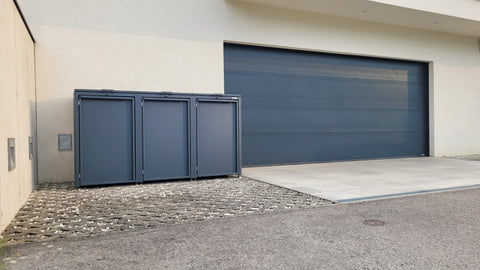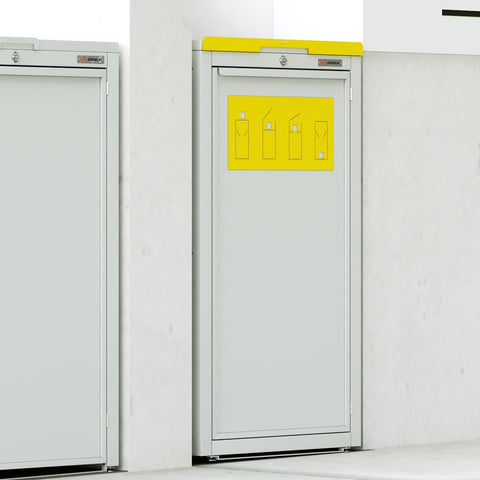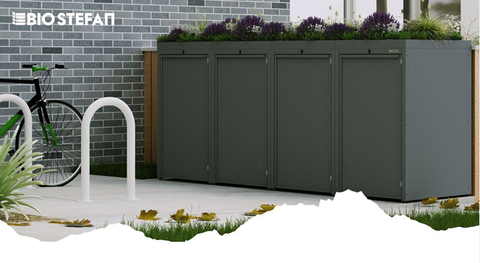Are you thinking about building a prefabricated house and want to know everything about the costs? Then you are in the right place! In this article, you will learn everything you need to plan your dream home.
Find out how the costs for a prefabricated house are composed and which factors can influence the price. From land costs to building permits to the costs of the house construction itself, we provide you with all the important information you need to keep your finances in check.
Additionally, we will discuss various financing options so that you get an overview of your choices. Whether you prefer a construction loan or a prefabricated house provider financing model, we help you make the right decision.
Learn now everything you need to know to plan your dream home and keep an eye on the costs.
Introduction to prefabricated houses
When financing a prefabricated house, you have various options. One option is to take out a construction loan from a bank. This allows you to buy the prefabricated house immediately and spread the costs over a certain period. Another option is financing through the prefabricated house provider itself. This can offer attractive terms since the provider already has experience in financing prefabricated houses.

Advantages of prefabricated houses
Before you make a final decision on a prefabricated house, you should compare the costs with those of conventional construction methods. While a prefabricated house may initially seem more expensive, the long-term costs can be lower. Due to the shorter construction time and better energy efficiency, you can save money in the long run.
Types of prefabricated houses
Prefabricated houses come in various styles and designs. You can choose between modern, traditional, or even custom-designed prefabricated houses. Each house style has its own characteristics and price ranges. It is important to know the different options to find the house that fits your needs and budget.
A modern prefabricated house is characterized by clean lines, large windows, and a minimalist style. These houses are often energy-efficient and offer an open floor plan. The costs for a modern prefabricated house can vary depending on the features and size.
Traditional prefabricated houses often have a classic design reminiscent of conventional construction methods. These houses can include various architectural elements such as columns, porches, or dormer windows. The costs for traditional prefabricated houses can vary depending on the chosen materials and size.
Custom-designed prefabricated houses offer the opportunity to plan a unique home according to your own ideas. You can individually customize the floor plans, materials, and equipment. These houses offer high flexibility but also higher costs due to the tailored planning. For example, a wooden house offers many advantages of ecological construction. Wood can also be used to set many accents outdoors, such as with waste bin boxes with real wood inserts as illustrated in the following image. You can find the matching product here: Wooden waste bin box – this is how elegantly you can hide waste

No matter which house style you choose, a prefabricated house offers many advantages such as short construction times, high quality, and good energy efficiency. The costs can vary depending on the chosen house style, equipment, and location.
Factors influencing the costs of prefabricated houses
The costs of a prefabricated house can depend on various factors. It is important to understand these factors in order to make a realistic cost estimate. Here are some important factors that can influence the costs of prefabricated houses:
1. Land costs: The price of the land on which the prefabricated house is to be built can vary significantly. The location, size, and condition of the land are important factors that can influence the price. A plot in a desirable location or with special features can be more expensive.
2. House size and equipment: The size of the prefabricated house and the chosen equipment can have a major impact on the costs. Larger houses require more materials and labor costs, which can lead to higher expenses. The selection of high-quality materials and features can also result in a higher price.
3. Location and transport costs: The location where the prefabricated house is to be built can also influence the costs. The further the location is from the production sites, the higher the transport costs can be. The accessibility of the building plot can also affect the costs.
4. Building permit and regulations: The costs for the building permit and compliance with local building regulations can also add to the total costs. The type of building permit and the required approvals can vary depending on the location. It is important to consider these costs when estimating expenses.
5. Additional costs: In addition to the main costs for the prefabricated house, there are also additional costs that must be considered. These include, for example, the costs for developing the land, connecting to electricity, water, and sewage, as well as any costs for landscaping and interior design.
It is important to consider these factors in budget planning to make a realistic cost estimate.
Understanding the cost breakdown of a prefabricated house
To better understand the costs of a prefabricated house, it is important to know the cost structure. The costs of a prefabricated house consist of various components. Here is a breakdown of the main costs:
1. Construction costs: Construction costs include the costs for the actual prefabricated house, including materials and labor. These costs can vary depending on the chosen house style, size, and features.
2. Land costs: The costs for the building plot must also be considered. This includes the price of the land as well as any costs for developing the plot.
3. Building permit and regulations: The costs for the building permit and compliance with local building regulations should also be included in the cost structure. These costs can vary depending on the location.
4. Transportation costs: If the prefabricated house needs to be transported to the construction site, transportation costs may be incurred. These costs depend on the distance to the production site and the accessibility of the building plot.
5. Additional costs: Additional costs such as connection fees for electricity, water, and sewage should also be considered. Costs for landscaping and interior design should not be forgotten either.
It is important to understand the cost structure in order to make a realistic cost estimate and plan the budget accordingly.
How to plan your budget for a prefabricated house
Budget planning for a prefabricated house requires careful consideration and a realistic cost estimate. Here are some steps that can help you with budget planning:
1. Determine the total budget: Determine the total budget you have available for building your prefabricated house. Consider both the construction costs and additional costs such as land costs, building permits, and transportation costs.
2. Cost estimation: Estimate the costs for the prefabricated house based on your requirements and preferences. Take into account the chosen house style, size, features, and location.
3. Get advice: Get professional advice from a prefabricated house provider or a construction expert. They can help you with cost estimation and budget planning.
4. Plan a buffer: Plan a buffer for unforeseen costs. It is advisable to have some leeway in the budget to cover unexpected expenses.
5. Check financing options: Explore different financing options to fund the prefabricated house. Compare the terms of construction loans, mortgages, and financing models from prefabricated house providers.
6. Monitor costs: Keep an eye on costs during the construction process. Stick to your budget and regularly check whether costs remain within limits.

Careful budget planning is crucial to avoid financial problems during the construction process. Take the time to carefully plan your budget and keep an eye on your finances.
Ways to reduce prefabricated house costs
Although prefabricated houses offer many advantages, costs can sometimes exceed the budget. However, there are various ways to reduce costs and still realize your dream home. Here are some tips for cost reduction with prefabricated houses:
1. Size and features: Reducing the size of the prefabricated house can significantly lower costs. Consider which rooms and functions are really important and adjust the size accordingly. Opt for standard features instead of expensive extras.
2. Material selection: Choose more cost-effective materials that are still of high quality. There are a variety of material options that can be attractive in price without compromising on quality.
3. DIY: If you have craftsmanship skills, you can also consider doing some work yourself to save labor costs. However, it is important to realistically assess your skills and seek professional help if necessary.
4. Comparing offers: Obtain multiple offers from different prefabricated house providers and compare prices and services. This can help you find the best deal and potentially reduce costs. One example could be choosing the affordable Dagobert if the trash bin box should be cheaper.

5. Energy efficiency: Invest in energy-efficient options to save costs in the long term. This can reduce energy consumption and lead to lower energy bills.
It is important to find a balanced approach to reduce costs without neglecting quality and your individual living comfort. Take the time to research your options and find the best solution for your budget.
Financing options for prefabricated houses
Financing a prefabricated house can be done in various ways. Here are some common financing options you can consider:
1. Construction loan: A construction loan is a common option to finance the construction of a prefabricated house. You receive financing for the construction of the house, which is usually paid out in installments. After completion of the construction, the construction loan is converted into a mortgage.
2. Mortgage: A mortgage is a long-term financing option for purchasing a prefabricated house. You borrow the money from a bank or lender and repay it over a certain period. The mortgage is secured by the prefabricated house as collateral.
3. Financing model of the prefabricated house manufacturer: Many prefabricated house providers also offer their own financing models. These can be specifically tailored to the construction of prefabricated houses and offer attractive conditions. Compare the offers of different providers to find the best financing option.
4. Own savings: If you have sufficient savings, you can also consider financing the prefabricated house with your own funds. This can give you flexibility and un
Comparison of the costs of prefabricated houses with traditional construction methods
The cost of building a house is a decisive factor for most people. Therefore, it is important to compare the costs of prefabricated houses with those of traditional construction processes. Here are some key points to consider in this comparison:
Conclusion: Is a prefabricated house right for you?
The decision to build a house is a major financial investment. Costs play an important role in this. Prefabricated houses can be a more cost-effective option compared to traditional construction processes, but you also need to carefully weigh the pros and cons.
Before deciding on a prefabricated house, it is advisable to consider various factors such as material costs, labor costs, time savings, energy efficiency, and customization options. Conduct thorough research and consult professionals to make the best decision for your dream home.
A prefabricated house can be a great option to save costs while still obtaining a high-quality and energy-efficient home. However, if you have specific customization requirements, you may want to consider other options.
The most important thing is to keep an eye on your finances and realistically assess the costs of the prefabricated house. With careful planning and advice, you can build your dream home without exceeding your financial limits.
---




